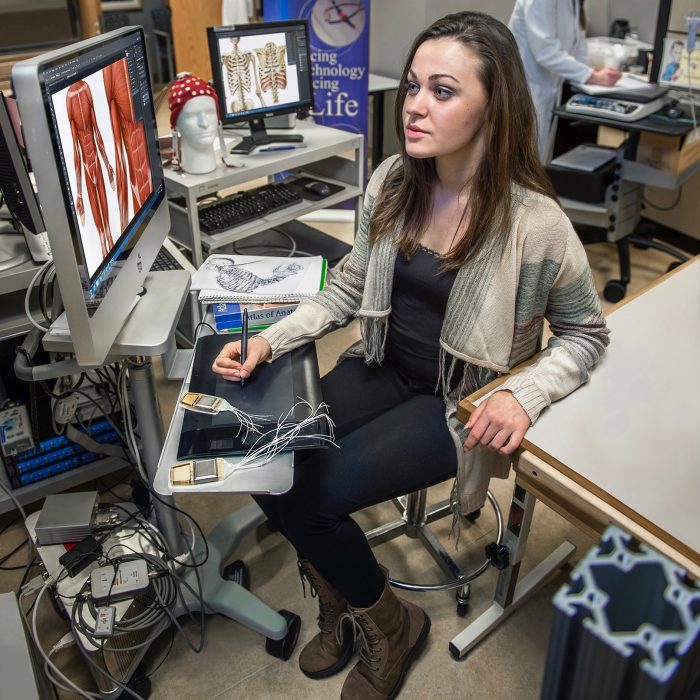Art School of the Future…Exists Now

This Cleveland Institute of Art Biomedical Art major illustrates patient education materals in an internship at a nearby hospital.
By Deborah Obalil,President at Association of Independent Colleges of Art & Design (AICAD)
Originally posted on LinkedIn on 4/15/16
Recently, Ruby Lerner of Creative Capital penned a post on Creativz.us describing how she would design the Art School of the Future. As President of the Association of Independent Colleges of Art & Design (AICAD), a consortium of 42 of the leading art and design schools in the US and Canada, I know that the comprehensive artistic and life skills education Ruby envisioned in her post exists now at our member schools. I share my response to her post:
As someone who has long advocated for artists of all disciplines to take greater control of their careers, and lives, through becoming educated about the business side of an artistic career, I couldn’t agree more with Ruby’s vision of a well-rounded artistic education. I am pleased to say that Ruby’s “art school of the future” exists today at the member institutions of the Association of Independent Colleges of Art & Design (AICAD). Since Creative Capital works with artists a bit further on in their careers, Ruby may not be aware of the significant changes that have been and continue taking place in art schools across the US and Canada. As President of AICAD, I can attest to the abundant resources available to art students at our member institutions in the areas of career planning, internships, entrepreneurship, financial literacy, intellectual property law, marketing and branding, and general management. With 42 member schools, it would take a book to cover all the opportunities at each school, but I offer a few examples to demonstrate the range and highlight how these opportunities are being integrated into the curriculum from the earliest points of a student’s education.
Columbus College of Art & Design requires a business and career prep course in the first year of their undergraduate curriculum. All students are enrolled in either Collaboration Across the Design Disciplines or Studio Art and Entrepreneurship in their first year. Not only are these courses required, they act as the first course of a 15 credit business minor that can be completely integrated with a student’s major with no additional time to completion of the degree.
Oregon College of Art & Craft has multiple required courses throughout their undergraduate curriculum including: The Business of Art in the 2nd year, Writing for Artists in the 3rd year, and then a 4th year Professional Practices course where students collaboratively organize, fundraise, market and curate their off-campus exhibition.

Columbus College of Art & Design MindMarket Flex Space – students gain exposure to real-world creatives and the work they do, while expanding their own portfolios and networks.
School of the Art Institute of Chicago, which has long eschewed any required courses and where students do not declare a major, has added a required Professional Practice Experience course for all third year students. This is in addition to the wide range of professional development activities offered through their Career + Co-Op Center connecting students with alumni, business professionals and entrepreneurs for mentoring and career guidance.
Moore College of Art & Design requires all students to complete an internship as part of their undergraduate degree, regardless of major.
ArtCenter College of Design, Pratt Institute, and the University of the Arts all have incubators that support students in developing ideas into viable businesses.
Maryland Institute College of Art is launching Up/Start MICA, a college-wide entrepreneurship initiative that allows students and recent graduates to launch start-ups and grow businesses. At the graduate level, students participate in professional development modules covering a range of topics including grant writing, making money from your work, the studio visit and next generation web presence. These modules are in addition to a robust offering of networking and professional development opportunities outside of course work.
As I said previously, this is just a smattering of examples from across the membership of AICAD. These schools take very seriously their mission and responsibility of preparing artists and designers for life beyond higher education. It is a myth that art students/graduates of present time and place are not trained in real life skills outside of studio practice. Art students are perhaps more prepared than many other disciplines today for a changing world, as they are trained to be self-motivated project managers who often present their work and ideas to an undefined public.
Creative Capital does incredibly important work with artists, and their funding has been a critical investment in artists at a time when the National Endowment for the Arts dis-invested at a large scale due to politics. I don’t deny that the artists they’ve worked with to date have benefited greatly from their professional development resources. However, I would be willing to bet that those resources could be invested in other ways in the near future as art students come out of their educational experiences better prepared and supported by institutions of higher learning than ever before.